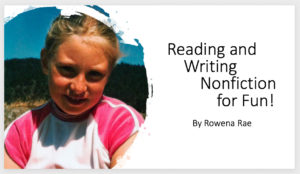Author Visits
I would love to visit your classroom or gathering to talk with your students about researching, writing and revising and about the content of some of my books!
I offer in-person and online visits of 30 to 45 minutes to grades 4 through 8, and I will tailor my presentation according to your and your students’ interests.
Contact me to discuss my programs and your needs, and to book a visit.
Author Visit Programs
Reading and Writing Nonfiction for Fun!
 In this interactive presentation, I talk about true stuff—nonfiction! I discuss with students where I get my book ideas and give them tips on coming up with their own writing ideas. I explain how and where I gather information, including from interviews; depending on grade level, I go less or more deeply into types of sources and how to find and evaluate them. I then talk about ways to organize nonfiction ideas and how to get beyond the scary blank page and start writing—and keep going until they have a complete first draft.
In this interactive presentation, I talk about true stuff—nonfiction! I discuss with students where I get my book ideas and give them tips on coming up with their own writing ideas. I explain how and where I gather information, including from interviews; depending on grade level, I go less or more deeply into types of sources and how to find and evaluate them. I then talk about ways to organize nonfiction ideas and how to get beyond the scary blank page and start writing—and keep going until they have a complete first draft.
Next comes the most important part of all: revising! I discuss ways for students to approach revising both their own writing and their peers’ writing, tailored to grade level. I also share real examples of my manuscripts and show how I revised them to get to the final draft. Time and interest permitting, I will also talk about sourcing and crediting photos and other images to accompany students’ nonfiction writing projects.
For grades 4 through 8.
Write, then Revise … and Revise Some More!
In this presentation, I take a deep dive into the art of revising to create the clearest, most engaging, most polished writing possible. Although I focus on nonfiction, the strategies and tips I give students can also be applied to fiction writing. I use examples from the drafts of my published books to show how I self-revised and then how I revised some more to address my editor’s comments.
This presentation includes hands-on work for students to revise short writing samples together in small groups during the session.
For grades 6, 7 and 8.
Rachel Carson Changed Your Life. Mine Too. But How?
Rachel Carson changed our lives today by speaking up in the 1950s and 1960s about something that she believed was wrong. She told the world about dangerous pesticide use in the United States and elsewhere in the world, and she did this by writing a book called Silent Spring. With this book, she opened people’s eyes, changed attitudes and laid the groundwork for antipollution laws and environmental actions that benefit all of us living today.
In this presentation, I introduce Rachel Carson and the events in her life that motivated her to become first a scientist and then a nationally acclaimed science writer. I use Carson’s famous ocean books as examples of writing about what you know, and I discuss five key traits of a great nonfiction writer, again using Carson as the example. Throughout, I sprinkle in some information about the natural world and ecosystems, which were the foundation of Carson’s passion for life.
For grades 4 through 8.
We’re All Connected
Two of my books are titles in the Orca Footprints series—Chemical World: Science in Our Daily Lives and Upstream, Downstream: Exploring Watershed Connections. Both of these books examine connections in nature and in our lives, so during this presentation, I introduce some of these connections and facilitate an interactive session for students to think about what these connections mean to their own lives.
I first talk about some of the chemicals we come into contact with every day, from those that occur naturally to those made by humans, from ones that help us live and prosper to ones we need to think twice about. After discussing some of the chemicals that can harm our environment and how as individuals we might make a difference, I return to a key chemical needed for life: water, or H2O.
I then talk about how water and land connect in watersheds and how people are an integral part of the connection. I discuss some of our daily activities—which, of course, involve chemicals—and possible consequences for our own or someone else’s watershed.
Throughout, I emphasize that nothing in the natural world exists all by itself. I invite students to share their ideas about connections, and how to keep the good ones going and stop the not-so-good ones from happening.
For grades 4 through 8.
Something’s Fishy!
In this interactive presentation, I talk about the salmon’s amazing migrations and life cycle, and explain the role salmon play in connecting ocean and stream ecosystems, including linking streams to land and land animals. I discuss some of the historical and traditional uses of salmon by cultures around the northern hemisphere and then talk about some of the obstacles and pressures that these fish face during their lives.
The goal of the presentation is to help students make links between the varied ecosystems that salmon use, as well as links between the health of these ecosystems and people’s activities. I end the session with students brainstorming ways that they can make a difference for salmon—or any fish—living in a stream, lake or bay nearby.
For grades 4 through 8.
